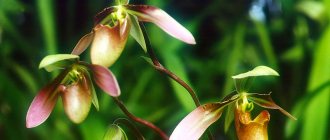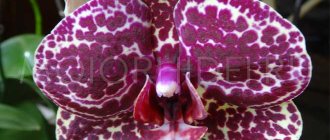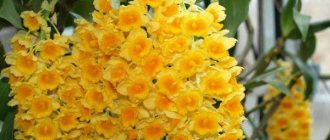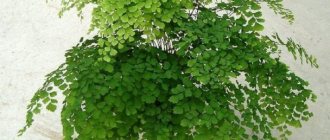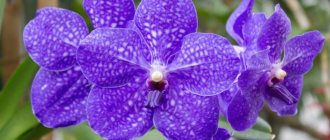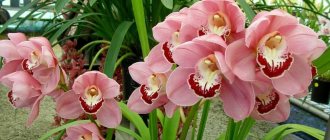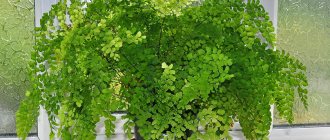Many lovers of indoor flowers are simply attracted to orchids - unusual flowers in shape and color, growing on a support. The Lady's slipper orchid variety is quite common.
Its flower is very similar to a small lady's slipper . But her charm lies not only in this. The delicate velvety color and spots on the leaves add exoticism to its appearance.
To successfully grow a tropical orchid, you need to create an environment close to its natural growth environment. The scientific name of the lady's slipper orchid is paphiopedilum . Many varieties of orchids require the same development conditions, but with Paphiopedilum everything is different.
Each type of paphiopedilum requires special care.
This type of orchid contains many varieties, each of which requires certain maintenance conditions . Some grow on rocky terrain, while others thrive in the ground. The composition of the soil for one or another subspecies is also different. Let's learn more about proper care of the Lady's Slipper orchid at home.
Optimal growing conditions
Suitable temperature
In the group of this variety there are warm- and cold-loving varieties. They can be recognized by the color of the flower:
- Bright inflorescences characterize heat-loving varieties;
- Elongated leaves with an intense green color are a cold-loving species.
Before the lovely paphiopedilum blooms, it is necessary to recreate a dormant period with an optimal air temperature of 10-15 degrees. If the accepted temperature fluctuations are not created, then flowering should not be expected.
This orchid is very susceptible to changes . For optimal growth and vegetation, temperature fluctuations can range from 18 to 25 degrees:
- In winter, the temperature should not fall below 10 degrees;
- In summer, do not rise to 33.
Comfortable air humidity level
Paphiopedilum loves moist air without foliar spraying. Optimal humidity is from 45 to 70%. If drops of water fall on the fragile leaves, unsightly spots will form on them.
We maintain a high level of humidity with expanded clay placed in a tray. At the same time, make sure that the bottom of the flower does not touch the water poured into the pan. For this purpose, a pot with a growing paphiopedilum is placed on an inverted saucer of a tray.
Advice! You can increase the humidity in your apartment air using a modern nebulizer.
Room illumination level
This type of orchid loves diffused light ; they cannot stand direct rays of the sun. On the south window, the delicate shoe is slightly shaded. It is also not recommended to keep orchids outside the window, since then they will require 12-hour lighting.
Current lighting conditions are changed gradually so that the perennial has time to adapt to the new environment. We move them from shade to sun every day for 3 weeks.
Attention! If the leaves of paphiopedilum take on a reddish color, then it indicates a strong degree of illumination and the plant requires shading.
Accommodation at home
The optimal place to place an orchid is home window sills :
- Northeastern;
- Eastern;
- And western windows.
The Lady's Slipper orchid does not need to be placed on a south window.
Some subspecies also feel great in the northern part of the house. The room where the perennial plant is kept requires frequent ventilation; in the summer it is placed in the garden .
To start flowering
To ensure the orchid blooms lushly, it is necessary to provide it with 16 hours of daylight. This can be done using a fluorescent lamp . If there is a lack of light, it reduces the level of photosynthesis; artificial lighting will help speed up the onset of flowering.
To increase the flow of light, wash the window frames , wipe the dust from the leaves, and place the perennial in a room with light walls and the same ceiling.
Description
A perennial herbaceous plant with a short, thick rhizome. The stem is 25-50 cm tall, with 3-5 alternate sessile broadly elliptical leaves. The flowers are solitary, large, with leaf-shaped bracts. The perianth is lilac or violet-pink (very rarely white or pale yellow), more or less monochromatic. The lip is 4.5-6.5 cm long, shoe-shaped, strongly swollen, wrinkled. The upper tepal is broadly ovate, directed horizontally forward, the lateral tepals are lanceolate, sharp, crescent-shaped forward and curve around the lip. The fruit is a capsule.
Features of care
First steps after acquisition: transplantation
After purchasing, you need to carefully examine the orchid to identify areas damaged by disease or pests. After purchase, the florist performs the following manipulations with the orchid:
- Place the newly acquired plant separately from other inhabitants of indoor plants. After this, you can safely introduce the new orchid to your neighbors;
- If you find bark with a white coating in a pot of paphiopedilum, you should throw it away immediately;
- Do not immediately expose the perennial to the sun, accustom it gradually;
- If there are no drainage holes in the pot, they can be pierced with a hot nail;
- At the beginning of adaptation, it is better not to bother the orchid by replanting it immediately after acquisition; it is better to wait until it grows;
- To maintain moisture, wipe the leaves with a moistened cotton pad.
All these recommendations will help the orchid quickly adapt to the new reality.
Watering and fertilizing
Immediately after purchasing, we do not rush to water the orchid; we wait 7 days for the soil to dry completely . For the Lady's slipper orchid, it is important to adhere to the optimal watering regime and not allow the roots to dry out or rot, because the perennial simply cannot tolerate this.
The frequency of watering depends on:
- Selected soil;
- And the degree of air humidity.
We water the perennial with settled water with a minimum salt content, this is very critical for it. We water the plant in the morning so that all the droplets of water in the sinuses dry out.
Advice! To avoid problems with the development of various fungal diseases, simply blotting the plant's rosette with a napkin if water gets there.
Lady's slipper is susceptible to excess feeding, so this is not done so often - 2 times a month. At the same time, we alternate organic and mineral fertilizers, adding half the dose taken.
It is necessary to feed the orchid during active growth.
The plant needs to be fed only during active growth ; it is not required during abundant flowering. In winter, the perennial needs feeding once a month. To prevent increased formation of salts due to the application of fertilizers, we wash the substrate monthly.
Ways to stimulate flowering
In order for paphiopedilum to bloom, it is important to observe changes in room temperature. For varieties with leaves of an intense green tone, for beautiful flowering it is important to observe a certain temperature regime , which differs during the day and at night.
These species prefer the heat of the day combined with the coolness of the night:
- During the daytime, the air temperature should be within 24 degrees;
- At night - from 10 to 12 degrees.
Varieties that bloom variegatedly require warmer air at night - from 15 to 17 degrees. At the same time, we make sure that the room is not too hot, otherwise there is a risk of losing the fragile orchid forever.
Lady's slipper will delight you with magnificent flowers. Follow the basics of caring for it, and the result in the form of lovely flowers will not be long in coming. To stimulate flowering, you need to follow the watering schedule, do not allow the soil to dry out, or water to stagnate in the outlet under the pot.
Trimming
After a long period of dormancy, the beautiful Paphiopedilum begins its flowering period . A peduncle appears from the middle of a strong rosette. Depending on the shape of the perennial, there may be only one flower on it.
It will stand on the peduncle for 2-4 months. With proper care, the plant will please the eye for 6-7 months. It is important for novice gardeners to know that one peduncle blooms only once .
It is for this reason that in varieties with one flower the strong peduncle is cut off, while in varieties with another beautiful flowering the stem is left until the end of flowering.
Nuances during a period of long rest
A dormant period is usually observed for varieties of the beautiful orchid with spotted leaves. This period is necessary, because it is followed by lush flowering. Rest for Venus's slipper begins in November.
Careful care for it during this period is simple: maintaining the air temperature at 15 degrees with periodic spraying of the soil substrate with water without fertilizing . After the peduncle emerges, this period ends.
Prevention of diseases and pests
The Paphiopedilum orchid has leaves and roots that are susceptible to various diseases and pests. During its care, leaf blades often die off . Depending on the symptoms, there are several objective reasons for this phenomenon:
- The leaves first acquire a yellow color, then turn brown - the result of natural death;
- The top of the leaf becomes almost black, then the entire edge of the plate darkens - this indicates that the plant is oversaturated with fertilizer or is infected with a dangerous fungus.
The mold fungus botrytis causes a fragile orchid to shed unopened buds. This may be due to lower air temperatures at night and increased humidity.
There are many pests of the Lady's slipper orchid.
Among the dangerous pests, the lush Lady's slipper orchid is most often attacked by :
- Flat beetle mites;
- Mealybugs;
- And scale insects.
“Catching” bees
It is believed that the orchid's closest relative is the lily, but the flowers are similar to each other only in that they have the same number of petals - six. But if a lily has symmetrical petals, then an orchid has a completely different structure. The flower changed its shape, becoming very attractive to insects and bees, creating ideal conditions for pollination. One of these changes is a highly elongated petal, which has become a “landing platform” that is very difficult for a potential pollinator to fly past.
This petal is called the lip. For bees and insects, the lip looks like an easily accessible treat “on a plate”, which also releases a pleasant aroma. But once on it, the insect, in order to get to the pleasant nectar located inside the bowl, needs to get inside the flower through a very narrow passage.
After a pleasant meal, the insect will have to struggle a lot to get back out. Getting out of the narrowed part of the flower, the insect begins to unfold in the flower, and it is almost impossible to do this without touching the stigma of the flower and leaving pollen from other flowers on it, and without collecting pollen from the anther onto itself.
The most remarkable thing is that the stigma is first touched for pollination from another plant, and only then, at the very exit from the flower, the insect collects pollen on itself, thus eliminating the possibility of self-pollination.
Landing Features
The success of growing the Lady's slipper orchid depends on the correct soil substrate . As the basis for the soil composition for paphiopedilum, natural pine bark and peat are used for planting seedlings in a ratio of 3:1.
In addition to the main composition, flower growers add a small number :
- Charcoal;
- Natural river sand;
- Natural expanded clay;
- High-quality sphagnum moss to preserve life-giving moisture.
In terms of acidity, the soil composition for orchids should be :
- Neutral;
- Or slightly acidic.
Pot
To grow this variety of orchids take :
- Plastic;
- Or clay containers.
The walls of clay dishes have pores that can allow air to pass through to the roots of the perennial. Transparent plastic makes it convenient to monitor susceptible root systems.
Due to oversaturation with moisture, the walls of a transparent pot may become covered with green mold, so it is additionally moved to a flower pot. Plastic containers are very convenient for seasonal replanting ; the plant can be easily removed from it. The neck of the plastic pot should be wider than the base.
Attention! The bottom of the flowerpot should have a hole for draining water.
Technology
- Carefully remove the plant;
- We inspect the root system;
- We remove rotten roots;
- We carefully treat the cuts with crushed coal.
When replanting, take into account the height of the transplanted plant.
A perennial planted too high will simply have roots that hang and stop developing. A perennial planted too low can cause the rosette to rot. Compacting the substrate is not required here.
A thorough inspection of the roots and substrate should be done every 6 months . For this purpose, the roots are removed from the container and their condition is carefully assessed.
Timing and technology
A mature perennial is replanted annually, but a young orchid needs to be replanted every 2-3 years. To undergo a transplant, at least one of the following :
- 8 or more sockets are formed in a plastic container;
- The new young shoot has become stronger and needs to be divided;
- After flowering ends;
- If the soil substrate is too saline, which negatively affects the general condition of the perennial;
- If spring has arrived, this is the optimal time to replant any perennials.
Some gardeners change the soil every 8 months. Replanting an orchid during flowering is impossible , as this negatively affects the state of flowering.
The Legend of Venus's Slipper
In ancient Greek mythology there is a legend about the slipper of Venus, or more precisely about the slippers of Venus, which turned into a beautiful flower.
A thunderstorm caught Venus and Adonis while hunting; they hid from the rain in a secluded, quiet place and indulged in lovemaking. A man passing by did not notice Venus with her lover, but saw her shoe made of pure gold abandoned on the ground. And as soon as the commoner stretched out his hand to pick up the shoe, it instantly turned into a flower resembling a shoe.
How to revive a perennial without roots?
If your paphiopedilum orchid has practically no roots left, then you need to start restoring them as quickly as possible. Small drying of the soil substrate stimulates the formation of roots , this fact has been noticed by many gardeners trying to restore orchids.
Daily spraying of the soil surface and the bark fraction on the soil gives results. To restore an orchid, you do not need to create special conditions for it or place it in a greenhouse. All these measures will give a good result after 2 months, when the young roots get stronger.
Every third watering we feed the diseased plant with fertilizer for lush orchids. “Rainbow” is suitable for these purposes. In hot months, water it more often .
Spreading
In the Vologda region it is located on the northern border of its range and was found only in the Vozhegodsky district (environment of the village of Boyarskaya) in 1972. The discovery of this species, as well as other rare orchids, served as the basis for the creation of the Northern Orchids BPP on this territory in 1982. . This location is apparently of an island relict nature. The main range of the species is in Asia. In Russia, it is more common in Western and Eastern Siberia, in the Far East; a very rare species in Central Russia. Outside Russia it is found in Mongolia, Japan and China. Boreal East European-Asian relict species.
Reproduction methods
This variety of orchids can only be propagated by dividing the bush . When many strong rosettes have appeared, division can begin. If there are at least 3 rosettes growing in the pot, then it can already be planted.
There are several ways to propagate orchids.
Divided orchids are placed in the shade, continuing to regularly spray the soil mixture until active shoot growth . This is followed by the usual care of the perennial.
Plant species
Real lady's slipper
The incredibly beautiful plant Cypripedium calceolus L is 50 cm long and has a capsule fruit. The roots are creeping, thick and short, the root appendages are long and twisted, growing up to 30 cm.
The stems are covered with hairs, the lower ovary is also downy. Leaf parameters: width 8 cm, length 18 cm, slightly wavy surface, elliptical shape with a pointed end. The bracts are leaf-shaped, large, the flowers are zygomorphic, of both sexes. The perianth has brown and red leaves. The lip of the flower is light yellow, puffed up.
real lady's slipper
Lady's slipper spotted
The small plant Cypripedium guttatum sends out long, creeping roots into the soil. The height of the stems is 15-30 cm. The speckled slipper has elliptical leaves with a sharp tip, their length is 12 cm. There are hairs on the edges and veins of the leaves. The leaf-shaped bracts are lanceolate-ovate in shape.
Flowering of the spotted slipper begins in late May or early June and ends in mid-July. The fruits appear in August and September. This species is valuable for breeding and has excellent decorative qualities. The spotted slipper is cultivated in many botanical gardens.
lady's slipper spotted
Lady's slipper grandiflora
The stems of the plant Cypripedium macranthos are from 20 to 25 cm in length, the roots are creeping, thin. The stamen in the flower is speckled white. The length of the lip is up to 7 cm, it is very inflated, shoe-shaped with a small hole at the top. The edges of the lip are turned inward. There may be 1-2 flowers on the plant. They have an impressive size - their diameter is 10 cm.
At the peak of the flowering season, the flowers emit a pleasant vanilla scent. Flowers can be white, dark red or pink. An inflorescence forms inside the bud 2 years before flowering. The roots grow slowly, up to 4 mm per year.
lady's slipper grandiflora
Lady's slipper garden
Cypripedium is grown in the garden. The plant tolerates being in the shade well. There are hybrid forms of cypripedium that are resistant to low temperatures.
Garden hybrids of the Lady's slipper flower are optimally suited for growing in gardens located in central Russia. This area has a specific climate - up to +30 degrees in summer, below -5 degrees in winter. Orchids overwinter under the snow. Garden hybrids are grown from seeds; they successfully adapt to the soil, grow quickly and live for decades.
Lady's slipper garden
Main growing problems
If Paphiopedilum is grown from a single rosette, then it is incredibly difficult for it to grow leaf mass. Rotten roots can be from :
- Incorrect watering regime;
- Overfeeding;
- Poor quality soil composition.
You should not rush to remove a faded rosette, because the life and development of new rosettes depends on it. Paphiopedilum acquires its own roots only in the second year of life.
When the neck is deeply deepened, it begins to come into contact with a moist substrate , which negatively affects the development of the flower.
You need to be extremely careful with the leaf blades of the orchid, because direct rays of the sun can burn them, so brown spots can form on them. To protect the plant from spider mites, wipe its leaves once a week with a damp cloth .
Lack of flowering may also indicate non-compliance with irrigation regime and temperature changes. The dying off of faded buds is a normal renewal process and should not be alarmed.
Botanical dossier
About 60 species of orchids are classified as cypripediums, although various sources name a different number of lady's slippers. A certain confusion is caused by the fact that orchids from several genera are named by one name.
Unlike its capricious relatives, cypripedium is a hardy plant with a powerful creeping rhizome and equally strong stems that can withstand the rather harsh conditions of a cool climate. From each pagon grow large leaf plates of an elongated oval shape with a characteristic pointed tip.
The flowering stem at the crown forms from 1 to 5 buds. Flowers are medium in size, of various colors and with various patterns in the form of strokes, polka dots, and streaks. The lip is shaped like a shoe, typical of a shoe, and the petals flow down like ribbons. Many cypripediums have a pleasant aroma and are of interest to beginning orchid growers.
Diseases and pests
Particularly dangerous is brown leaf spot, which occurs from :
- Excessive moisture;
- Drying out;
- After using a low-quality substrate.
In order to prevent dangerous diseases, the following is carried out :
- Disinfection of the pot;
- And treating the perennial with phytosporin.
If affected leaves are found, they are destroyed, and the pot with the growing orchid is placed in a well-ventilated place. The perennial is treated with a fungicide .
Of the pests that attack perennials, the most dangerous are :
- Aphid;
- Mealybug;
- Common scale insect;
- Slugs.
You need to deal with them in the standard way. Plants and soil substrate are treated with a prepared solution of karbofos, the concentration level here is 0.1% -0.2%. If there are slugs or snails, formaldehyde is added to the solution.
When growing this orchid variety indoors, foliage problems
- Elongated and brightening leaf blades are the result of a lack of light or nitrogen deficiency;
- Elongated leaves of a rich green tone, falling buds indicate an excess of nitrogen, we stop adding this element and add potassium instead;
- The leaves take on a reddish tint - you need to place the flower in the shade to eliminate the possibility of burns;
- When the top leaves are crushed, the perennial is replanted; if the root system is poorly developed, at elevated temperatures in the summer heat the perennial should be fed;
- Dying of young roots - increased concentration of soil acidity or excess fertilizer, the plant is affected by snails;
- Drying of young shoots is a lack of moisture; frequent spraying of the substrate will help get rid of it.
If young strong shoots begin to turn black at the base and die, we destroy the dead parts and treat the plant with copper chloride . In this case, you need to ensure that drops of moisture do not fall into the base of the young rosette.
Advice! If the plant is affected by aphids, it must be treated with an insecticide.
Popular message topics
- City of Omsk
Omsk is one of the largest Russian cities with a million population, the eighth most populous in Russia and the second in Siberia (as of 2022, 1,172,070 people live in Omsk). The city is a major scientific, cultural and industrial - Goose
Everyone is familiar with animals such as geese; many have encountered them in person, for example, at their grandmother’s in the village. Today we will look at the habitats of geese, external structure, reproduction and nutrition. Let's get started. - Tropical Plants
Tropical forests are located near the equator. These amazing and largely unexplored forests are divided into tropical rainforests and dry deciduous forests. The tropics predominate in countries such as Mexico, Australia, Asia, Central and South
Reviews
Marina. “I first purchased a Lady’s Shoe about five years ago. The only problem we had to face was leaf burn. Therefore, I strongly recommend that everyone protect their plant from direct sunlight, they are detrimental to this plant variety. Paphiopedilums are incredibly beautiful plants that transform any room with their presence and delight guests. They are also suitable for beginners, as the care features are very easy to understand. I recommend!"
Anna. “I can’t imagine my home without orchids. All the window sills are installed, but I want more and more. I recently purchased a Lady’s slipper – an incredibly beautiful flower. If you properly provide the plant with everything it needs: moisture, light, temperature, then flowering is 100% guaranteed. The only thing that’s not very pleasing is the price, and it’s not always easy to find this particular variety in stores.”
Olga. “I’ve been growing Paphiopedilums for quite some time. First of all, I recommend that beginners not be lazy and replant the flower once a year. We all know that tap water is not the cleanest and over the course of a year a sufficient amount of salts accumulate in the root system, which simply destroy the flower. You can stock up on substrate in advance and make it yourself, saving money. Many varieties of orchids do not like replanting, but not Lady’s slipper, they have quite sensitive roots.”
Beneficial features
The plant contains many useful substances, so slipper infusions prepared according to ancient recipes are widely used for insomnia, childhood fear, mental illness, epilepsy, headaches, and incontinence. Preparing the infusion is quite easy - add a teaspoon of dry herb to 200 mm of boiling water, let it sit for two hours and pass through a sieve. Drink for headaches, bleeding, hernias, and as a diuretic. But for depression and mental disorders, you can prepare another decoction - 10 grams of dry herb per 250 mm of water. Heat all this in a steam bath for 20 minutes. The cooled broth is best stored in the refrigerator.
For children, prepare your own decoction - pour half a teaspoon of dry herb into one glass of boiling water, leave for at least 8 hours, and filter thoroughly. The child is allowed to drink no more than 1/3 glass, always before meals - about 20 minutes before. If the decoction is taken by a person as a course of treatment, then they drink it as follows. 20 days daily, then they give a break of 10 days. The most remarkable thing about taking a folk remedy is the complete absence of contraindications. A decoction of the large-flowered slipper will only be beneficial, without causing absolutely any harm.
